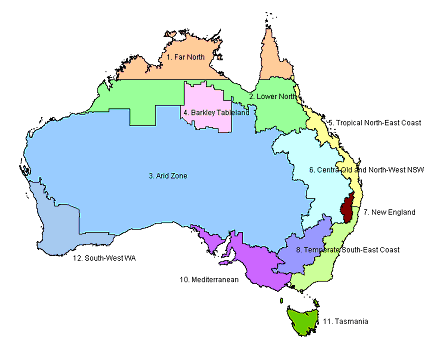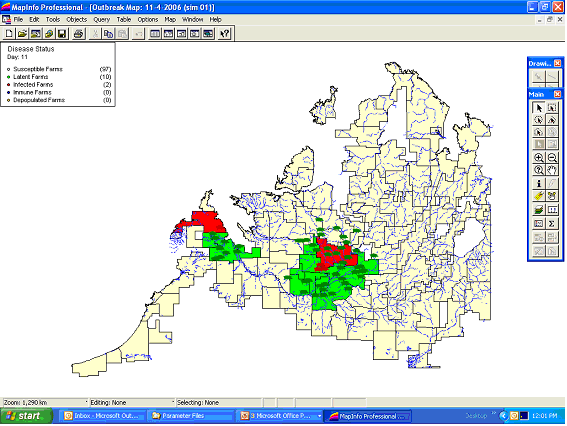Concern about exotic and emerging disease threats has prompted interest by animal health agencies involved in preparedness and planning to use decision support tools such as animal disease modelling. Foot-and-mouth disease (FMD) continues to represent the most serious threat to Australian livestock industries. An outbreak of FMD would seriously impact both Australia’s livestock sector and the economy as a whole. Potential consequences of a disease outbreak include the immediate loss of international market access, disruption of the domestic market for livestock and products, severe production and income losses in livestock and related industries, and the financial, political and social pressures of eradicating the disease. Recent estimates suggest that losses could vary from $7.1 billion for a small three month outbreak to $16 billion for a large 12 month outbreak (Matthews report, 2011). Disease planning and preparedness are key components to reducing the risk of FMD introduction and spread in Australia.
Decision support tools including disease models can offer valuable insights in understanding the risks of FMD spread and control in the event of an outbreak. They can be used to test the effectiveness of different control strategies and assess the effectiveness of resource constraints and limitations. The findings from modelling studies can be used to assist with emergency animal disease planning and preparedness.
The Australian Government Department of Agriculture, Fisheries and Forestry uses a regional FMD simulation model, AusSpread, to model the spread and control of FMD in Australia (Garner and Beckett, 2005). AusSpread is a stochastic spatial simulation model that simulates the spread and control of FMD in livestock populations in various regions in Australia. AusSpread has been used extensively both in Australia and internationally (Roche et al, 2014, Sanson et al 2007). In addition to its regional modelling capabilities, the department has recently developed a national scale simulation model, the Australian Animal Disease Spread model (AADIS), capable of spreading and controlling disease across Australia (Bradhurst et al., 2015). This model is in its final stages of development and testing.
Regional models
AusSpread is a regional model, where disease spread and control is modeled in various regions of Australia as defined by natural or geopolitical boundaries. The rationale for a regional approach is that each region is characterized by reasonably homogenous animal production systems and environmental conditions. For a continent such as Australia, with diverse environmental and production systems, regions represent the most appropriate scale at which to assess control or eradication strategies (Fig 1).

Figure 1 Twelve Australian agricultural regions
AusSpread uses polygon or point location data to represent a farm, the epidemiological unit of interest. Data on the Australian farm population is synthesised and derived from agricultural census statistics, industry reports and data, and land use information. Disease spread is modelled in daily time steps and events occur stochastically. Five spread pathways are implemented in AusSpread, including live animal movements, fomite/equipment/human movements, aerosol transmission, local spread around infected premises, and saleyard spread. Australian contingency plans provide the framework for control measures. Model parametrisation is highly configurable, allowing 'what-if' scenarios to be trialled and control strategies tested.
The model is unique in that it has been developed within a geographic information system (GIS) environment. This provides ready access to sophisticated spatial functions and mapping capabilities (Figure 2), and allows for easy incorporation of spatial data layers, such as roadways, waterways, urban centres and elevation.

Figure 2 AusSpread map outputs
National models
A joint research venture between the DA and the University of New England has led to the development of Australia’s first national-scale model of livestock disease spread, AADIS (Bradhurst et al., 2015). AADIS builds on the key features of AusSpread including the use of five spread pathways, stochastic processing, and flexibility in resource allocation and options for control, with a number of notable differences. AADIS uses a herd as its epidemiological unit of interest, where one farm comprises one or more herds. This captures the heterogeneity of production systems that manage species or production classes differently on a farm.
Disease spread is modelled both within and between herds, and across Australia (Fig 3). Despite the large datasets required for such a model to run, AADIS runs extremely efficiently on a desktop computer. Efficiency is achieved through the use of a novel fusion of equation-based and agent-based modelling approaches. AADIS blends simple mathematical modelling of within-herd spread, with stochastic agent-based spatial modelling of between-herd spread. This overcomes the complex challenges of modelling diverse environments, varied farming and management practices, large datasets, and execution of control across several jurisdictions. AADIS efficiently models complex large-scale simulations across a national dataset of over 235,000 herds. Computational efficiency is important as a particular epidemic scenario may need to be re-run many hundreds of times to allow trends to emerge from the underlying stochastic mechanisms.
FMD is employed as the test case for AADIS, however, the model is flexible to accommodate other pathogens.

Figure 3 AADIS model outputs
References
Bradhurst, R.A., Roche, S.E., East, I.J., Kwan P., and Garner M.G. (2015). A hybrid modelling approach to simulating foot-and-mouth disease outbreaks in Australian livestock. Frontiers in Environmental Science, 3(17), doi:10.3389/fenvs.2015.00017.
Garner, MG and Beckett, SD (2005) - Modelling the spread of foot-and-mouth disease in Australia. Australian Veterinary Journal 83(12), 758-766.
Roche, SE, Garner, MG, Wicks RM et al (2014) How do resources influence control measures during a simulated outbreak of foot and mouth disease in Australia? Preventive Veterinary Medicine 113, 436-446.
Sanson, RL, Harvey, N, Garner, MG et al (2011) Foot and mouth disease model verification and ‘relative validation’ through a formal model comparison. Rev. Sci. Tech. Off. Int. Epiz. 30, 527–540.
Matthews, K (2011) A review of Australia’s preparedness for the threat of foot and mouth disease. Australian Government Department of Agriculture, Canberra.
